We take our mentors' lessons in the Minnesota Tip to bring a
tender tree through the winter.
Just dig a pit and bury it. It'll be fine!
Ah, the common fig, Ficus
carica. Gardeners so love this fruit that they jump
through hoops to grow it in their own garden, even though the
region is too cold to support a blooming, fruiting fig.
Although a fig's roots will weather winter in USDA hardiness zone
6 or a sheltered place in zone 5, the top of the tree won't survive
in air colder than about 15° F. Since it's the top of the tree that
must remain alive from year to year in order to produce fruit, a
fig's only reliable in the landscape when grown in zone 8 and 9.
One way around the cold winter is to grow the tree in a pot and
move it into a no-freeze building late each fall. Another method is
what we're doing here -- using a "Minnesota Tip" to bury the tree
as killing frosts begin in late fall.
This article was Sponsored by...
• Timing
• Digging the pit
• Tying the tree
• Cutting roots on one side
• Tip the tree
• Wrap it
• Burial
• Apply to other plants!
Timing
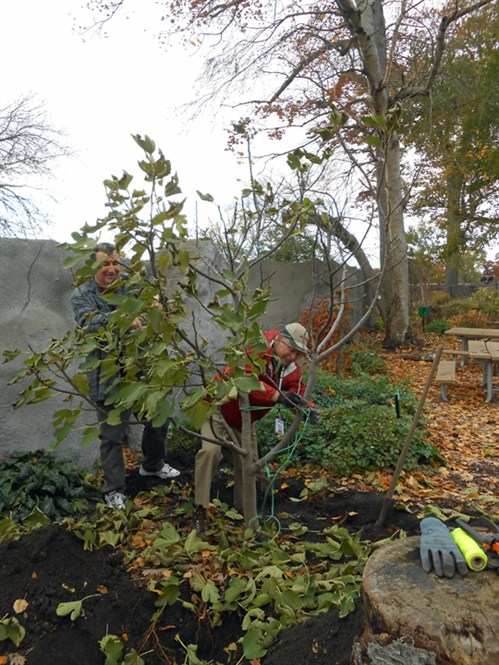 We pluck the leaves off the tree
We pluck the leaves off the tree
since they will not serve any
purpose underground and will
only drop off when we unearth
the tree in spring.
Ideally, we'd wait to tip the tree
after the cold made the foliage
drop. However, work in our
volunteer garden at the Detroit
Zoo is subject to the universal
imperative, that the best time
to do a thing is when we can.
Sure, there's a
'best time'
for everything, but
the time to do a thing
in the garden is
when you think of it.
Digging the pit
We've dug a pit from one side of the trunk about a foot deep,
two feet wide and as long as the tree is tall. (Below, right:
Paul in the orange cap is standing in the pit.) The width is a
guess, our estimate of how wide the tree will be once we tie its
branches. In four of the five years this tree's been in our
Detroit Zoo garden, we unearthed the tree entirely and buried it
where we had a perennial-free space. This year we knew it would
reach a size we'd rather tip than lift, so we planted only annuals
to one side of it.
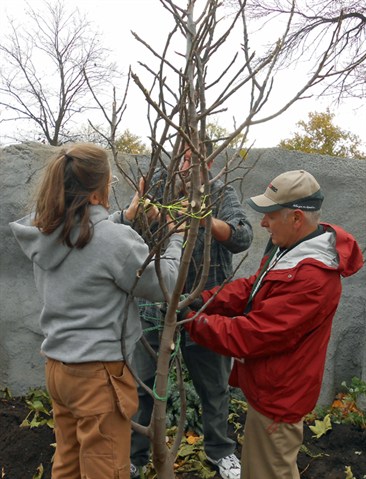
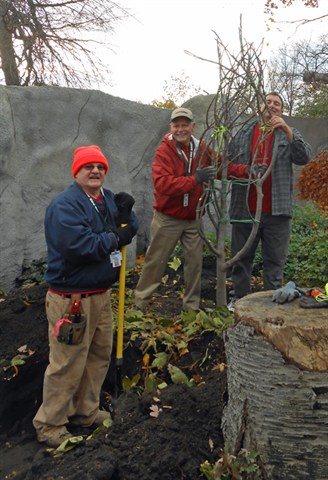
Tie the tree to make it
small
We press side branches together against their main branch and
use string or rope to hold them in that bundle. Then we pull the
bundled main branches to the trunk. The best ties are wide and soft
to avoid cutting into the bark.
Above, left: Janet's holding a group of branches to its
trunk while Gordon ties. Phil in the red jacket is pulling all the
main branch bundles together. If you don't have extra hands to
accomplish this feat, use elastic bungee cords to cinch the
branches in a series of ever-tighter bundles.
Why tie? We don't want to dig a pit as wide as this tree! Also,
bundled branches are stronger than individual twigs -- see
"Wrapping" for why we care about twigs.
Cut loose one side of
the root mass
The tree's tied. The pit's dug. Now we excavate around the far
side of the trunk, cutting through the roots about two feet out
from the trunk. We undercut the root mass on that side of the tree
and also remove soil from the root ball to lighten it.
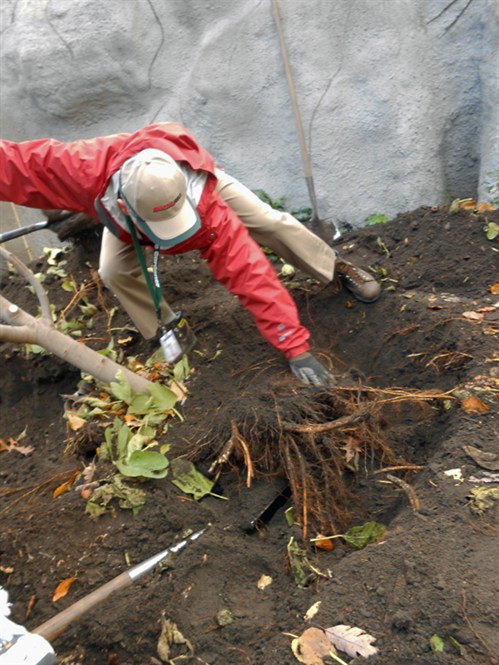 (Is this a man's job?
(Is this a man's job?
No, this crew came to
be this way simply by
serendipity. Janet's a part,
but is also the one to step
out of the frame to say,
"Wait, let's get another
picture." Phil Gigliotti is
in charge of this part of
our team's garden and
as experienced at wintering
tender trees as Janet, having
overwintered figs in his home
garden for decades.
Paul Needle jumped in as the
first person to arrive to find
Janet digging the pit.
Gordon Findlay stepped up
when we called for, "Someone
tall to come take off the
top leaves.")
Tip the tree
Now we tip the tree into the pit. In-ground, the tree's wood
will only be as cold as frozen ground, 32F. That's much warmer than
zone 5 air, which may drop to -20F.
Wrap the package
We wrap a tarp around the tree to prevent damage when we
retrieve it in spring. We want to avoid breaking the branch tips as
we dig. The tips must remain intact -- they are what is ready to
bloom and fruit. We had two crops from this tree this year, which
is common. The overwintered shoots bear first, then newer shoots.
(Usually the second crop is most tasty but we can't vouch for that
as we lost most of the fruit to squirrels. You will note that we
are not daunted. Another thing our mentors taught us is to always
look forward to next year.)
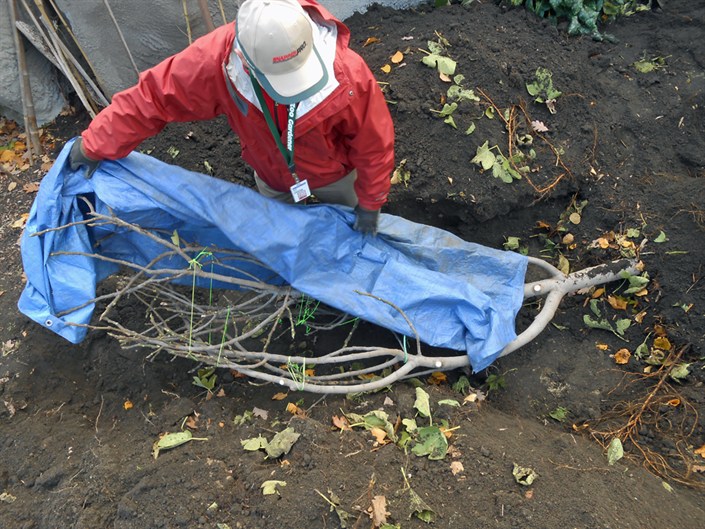
Burial
Then we bury the tree. We mound up over the tipped half of the
root ball. In this case, that took four wheelbarrows of soil and
rotted mulch stripped from our garden paths. We topped off the
mound with insulating straw. This was not essential but we had all
that "perennial straw" on hand -- cut down ornamental grasses, tall
annuals, etc.
Applies to other tender
perennials, shrubs and trees
We've showed you this process with a rose tree
and explained that you can also bury cannas, dahlias and other
tender perennials to take advantage of ground warmth. We've
explained how to achieve this protection
for hydrangeas that are only root-hardy, not branch hardy in
zone 5. (blue- and pink-blooming hydrangeas, Hydrangea
macrophylla varieties such as 'Nikko Blue', H.
serrata and its hybrids). Check out burying and other methods
in What's Coming Up issue 7 for tender
perennial tactics, or Wondrous Root Cellars
and Growing Concerns
591 for just about anything.
There are even more articles about winter protection here at
GardenAtoZ. Use our Search function to search key words such as
"winter (your plant name)"
This article was Sponsored by one of our
heroes, Bill Eyler:

To read more of our reader-recommended
articles...
To become a Sponsor...